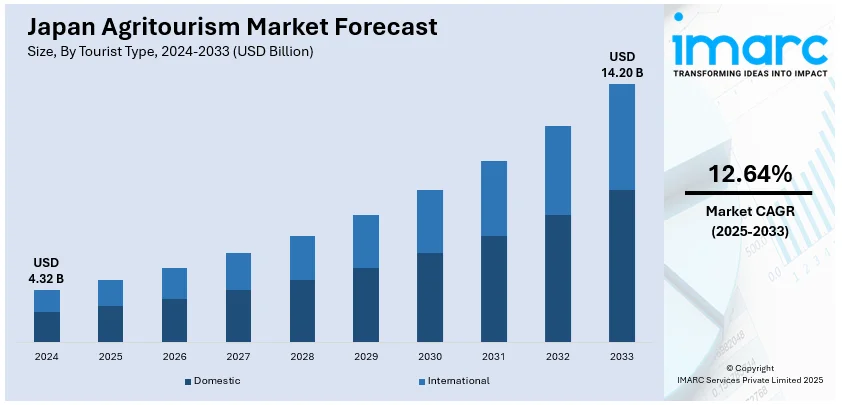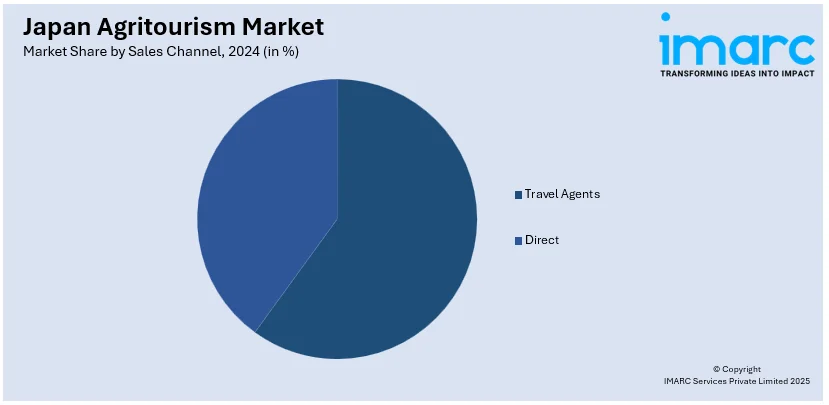
Japan Agritourism Market Size, Share, Trends and Forecast by Tourist Type, Activity, Booking Channel, Sales Channel, and Region, 2025-2033
Japan Agritourism Market Overview:
The Japan agritourism market size reached USD 4.32 Billion in 2024. Looking forward, IMARC Group expects the market to reach USD 14.20 Billion by 2033, exhibiting a growth rate (CAGR) of 12.64% during 2025-2033. The agritourism market is Japan is propelled by government initiatives aimed at revitalizing rural communities facing population decline and economic challenges. The integration of smart farming technologies enhances agricultural efficiency and visitor experiences, supporting sustainable development, economic diversification, and expanding the Japan agritourism market share.
|
Report Attribute
|
Key Statistics
|
|---|---|
|
Base Year
|
2024
|
|
Forecast Years
|
2025-2033
|
|
Historical Years
|
2019-2024
|
| Market Size in 2024 | USD 4.32 Billion |
| Market Forecast in 2033 | USD 14.20 Billion |
| Market Growth Rate 2025-2033 | 12.64% |
Japan Agritourism Market Trends:
Rural Revitalization and Government Support
Japan's agritourism industry is propelled by national initiatives aimed at tackling the urgent challenge of rural depopulation and economic decline, driven by the nation's swiftly aging population. According to government data in 2024, Japan's senior population reached a historic peak of 36.25 million individuals, with nearly one-third of the Japanese being 65 years or older. This demographic change is influencing rural regions, where older farmers and falling birth rates are low. To address the issues brought about by an aging populace and rural population decline, the governing body, working alongside local municipalities, is introducing various initiatives that encourage agritourism to foster economic diversification and rejuvenate communities. These programs consist of policies and subsidies aimed at promoting tourism activities focused on agriculture, local traditions, and natural surroundings, thus offering alternative revenue streams for rural inhabitants. Agritourism functions not only as a way to maintain traditional farming methods but also as a driving force for bringing younger people back to rural regions by creating job prospects and boosting local economies. Strategic initiatives also integrate agritourism into wider contexts of regional branding, infrastructure enhancement, and community involvement, establishing it as a viable method for rural advancement. This unified national initiative recognizes agritourism as a complex resource that goes beyond recreation and cultural encounters, representing an effective approach to the socioeconomic issues confronted by rural Japan. Japan is fostering resilient rural communities and encouraging balanced regional growth by aligning tourism development with long-term demographic and economic goals.

To get more information on this market, Request Sample
Technological Innovation and Smart Farming Integration
The rising adoption of smart farming technologies, which improve agricultural productivity and offer distinct, technology-driven rural experiences, is impelling the Japan agritourism market growth. A significant instance is the 2024 initiation of the Minano Digital Eco Farm initiative, a partnership involving SAP Japan, PSI, and the local government of Minano. This project deployed Internet of Things (IoT) technologies to link rural Saitama farms with urban buyers, facilitating real-time crop monitoring, remote involvement in farming activities, and sustainable farming practices based on data. By connecting technological advancements with local farming, such initiative rejuvenates rural areas, draws in tech-oriented visitors, and aligns with Japan's larger effort to sustainability goals. These initiatives convert farms into immersive educational spaces where guests can interact with traditional methods and contemporary farming technologies. This blend of traditional and contemporary offers an engaging story about rural progress, sustainability, and creativity for visitors. In addition, it frames agritourism as a forward-looking sector that responds to environmental, economic, and social issues. With many areas adopting comparable approaches, the smart farming initiative is anticipated to boost agritourism's expansion by increasing the attraction of rural areas and expanding its significance across various generations and interests.
Japan Agritourism Market Segmentation:
IMARC Group provides an analysis of the key trends in each segment of the market, along with forecasts at the country and regional levels for 2025-2033. Our report has categorized the market based on tourist type, activity, booking channel, and sales channel.
Tourist Type Insights:
- Domestic
- International
The report has provided a detailed breakup and analysis of the market based on the tourist type. This includes domestic and international.
Activity Insights:
- On-farm Sales
- Outdoor Recreation
- Agritainment
- Educational Tourism
- Accommodations
- Others
A detailed breakup and analysis of the market based on the activity have also been provided in the report. This includes on-farm sales, outdoor recreation, agritainment, educational tourism, accommodations, and others.
Booking Channel Insights:
- Online
- Offline
The report has provided a detailed breakup and analysis of the market based on the booking channel. This includes online and offline.
Sales Channel Insights:

- Travel Agents
- Direct
A detailed breakup and analysis of the market based on the sales channel have also been provided in the report. This includes travel agents and direct.
Regional Insights:
- Kanto Region
- Kansai/Kinki Region
- Central/Chubu Region
- Kyushu-Okinawa Region
- Tohoku Region
- Chugoku Region
- Hokkaido Region
- Shikoku Region
The report has also provided a comprehensive analysis of all the major regional markets, which include Kanto Region, Kansai/Kinki Region, Central/Chubu Region, Kyushu-Okinawa Region, Tohoku Region, Chugoku Region, Hokkaido Region, and Shikoku Region.
Competitive Landscape:
The market research report has also provided a comprehensive analysis of the competitive landscape. Competitive analysis such as market structure, key player positioning, top winning strategies, competitive dashboard, and company evaluation quadrant has been covered in the report. Also, detailed profiles of all major companies have been provided.
Japan Agritourism Market News:
- In July 2025, Pasona Group announced the opening of its agritourism resort, Hatake no Resort Sansan Villa, on Awaji Island, Hyogo Prefecture, starting August 1. The resort features 11 villas where guests can engage in seasonal farming activities like sowing and harvesting.
Japan Agritourism Market Report Coverage:
| Report Features | Details |
|---|---|
| Base Year of the Analysis | 2024 |
| Historical Period | 2019-2024 |
| Forecast Period | 2025-2033 |
| Units | Billion USD |
| Scope of the Report |
Exploration of Historical Trends and Market Outlook, Industry Catalysts and Challenges, Segment-Wise Historical and Future Market Assessment:
|
| Tourist Types Covered | Domestic, International |
| Activities Covered | On-farm Sales, Outdoor Recreation, Agritainment, Educational Tourism, Accommodations, Others |
| Booking Channels Covered | Online, Offline |
| Sales Channels Covered | Travel Agents, Direct |
| Regions Covered | Kanto Region, Kansai/Kinki Region, Central/Chubu Region, Kyushu-Okinawa Region, Tohoku Region, Chugoku Region, Hokkaido Region, Shikoku Region |
| Customization Scope | 10% Free Customization |
| Post-Sale Analyst Support | 10-12 Weeks |
| Delivery Format | PDF and Excel through Email (We can also provide the editable version of the report in PPT/Word format on special request) |
Key Questions Answered in This Report:
- How has the Japan agritourism market performed so far and how will it perform in the coming years?
- What is the breakup of the Japan agritourism market on the basis of tourist type?
- What is the breakup of the Japan agritourism market on the basis of activity?
- What is the breakup of the Japan agritourism market on the basis of booking channel?
- What is the breakup of the Japan agritourism market on the basis of sales channel?
- What is the breakup of the Japan agritourism market on the basis of region?
- What are the various stages in the value chain of the Japan agritourism market?
- What are the key driving factors and challenges in the Japan agritourism market?
- What is the structure of the Japan agritourism market and who are the key players?
- What is the degree of competition in the Japan agritourism market?
Key Benefits for Stakeholders:
- IMARC’s industry report offers a comprehensive quantitative analysis of various market segments, historical and current market trends, market forecasts, and dynamics of the Japan agritourism market from 2019-2033.
- The research report provides the latest information on the market drivers, challenges, and opportunities in the Japan agritourism market.
- Porter's five forces analysis assist stakeholders in assessing the impact of new entrants, competitive rivalry, supplier power, buyer power, and the threat of substitution. It helps stakeholders to analyze the level of competition within the Japan agritourism industry and its attractiveness.
- Competitive landscape allows stakeholders to understand their competitive environment and provides an insight into the current positions of key players in the market.
Need more help?
- Speak to our experienced analysts for insights on the current market scenarios.
- Include additional segments and countries to customize the report as per your requirement.
- Gain an unparalleled competitive advantage in your domain by understanding how to utilize the report and positively impacting your operations and revenue.
- For further assistance, please connect with our analysts.
 Request Customization
Request Customization
 Speak to an Analyst
Speak to an Analyst
 Request Brochure
Request Brochure
 Inquire Before Buying
Inquire Before Buying




.webp)




.webp)












